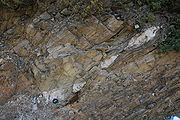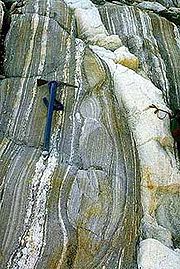
Boudinage
Encyclopedia



Competence (geology)
In geology competence refers to the degree of resistance of rocks to either erosion or deformation in terms of relative mechanical strength. In mining 'competent rocks' are those in which an unsupported opening can be made. Competent rocks are more commonly exposed at outcrop as they tend to form...
surroundings. The competent bed begins to break up, forming sausage-shaped boudins.
Boudins are typical features of sheared veins
Vein (geology)
In geology, a vein is a distinct sheetlike body of crystallized minerals within a rock. Veins form when mineral constituents carried by an aqueous solution within the rock mass are deposited through precipitation...
and shear zone
Shear zone
A shear zone is a very important structural discontinuity surface in the Earth's crust and upper mantle. It forms as a response to inhomogeneous deformation partitioning strain into planar or curviplanar high-strain zones. Intervening blocks stay relatively unaffected by the deformation...
s where, due to stretching along the shear foliation and shortening perpendicular to this, rigid bodies break up. This causes the resulting boudin to be its characteristic sausage or barrel shape. They can also form rectangular structures Ductile
Ductility
In materials science, ductility is a solid material's ability to deform under tensile stress; this is often characterized by the material's ability to be stretched into a wire. Malleability, a similar property, is a material's ability to deform under compressive stress; this is often characterized...
deformation conditions also encourage boudinage rather than imbricate fracturing.
In three dimensions, the boudinage may take the form of ribbon-like boudins or chocolate-tablet boudins, depending on the axis and isotropy of extension. They range in size from about 20 m thick to about 1 cm.
Types
There are three different types of boudinage. These include no-slip boudinage, s-slip boudinage, and a-slip boudinage. No-slip boudinage occurs when there is no slip, resulting in a symmetrical structure. S-slip boudinage occurs when the boudin moves in opposition to the shear movement, where A-slip occurs when it moves with the direction of the shear. These types can be further classified into 5 different groups with relation to their general shape. These groups are drawn, torn, domino, gash and shearband boudins. In general, drawn and torn shapes form where there is a no-slip bouninage, domino and gash boudins by A-slip and shearband boudins by S-slip boudinage.Etymology
Boudinage derives from the French word "boudinBoudin
Boudin describes a number of different types of sausage used in French, Belgian, German, French Canadian, Creole and Cajun cuisine.-Types:*Boudin blanc: A white sausage made of pork without the blood. Pork liver and heart meat are typically included...
", meaning sausage. Boudins were first observed and described by Belgian geologists in the Collignon quarry near Bastogne
Bastogne
Bastogne Luxembourgish: Baaschtnech) is a Walloon municipality of Belgium located in the province of Luxembourg in the Ardennes. The municipality of Bastogne includes the old communes of Longvilly, Noville, Villers-la-Bonne-Eau, and Wardin...
in the Ardennes
Ardennes
The Ardennes is a region of extensive forests, rolling hills and ridges formed within the Givetian Ardennes mountain range, primarily in Belgium and Luxembourg, but stretching into France , and geologically into the Eifel...
(Belgium
Belgium
Belgium , officially the Kingdom of Belgium, is a federal state in Western Europe. It is a founding member of the European Union and hosts the EU's headquarters, and those of several other major international organisations such as NATO.Belgium is also a member of, or affiliated to, many...
).

